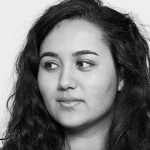
After 10 years of success in Paris, Paris Photo arrived in Los Angeles this past weekend and stunned visitors with its presentation and array of incredible photography. Red carpets led the way to three film studios at Paramount Pictures and the renovated interiors of New York City-inspired sets, which brilliantly took the place of typically large, basic art fair tents. The success of Paris Photo LA can be attributed to a combination of its excellent curation among 60 galleries and multiple book publishers, excellent programming, and its challenging of the standard art fair format. It didn't hurt that champagne was abundant and visitors felt like they were stars in a movie, where the outside world could be shut out in favor of enjoying art without distraction.
"In the postwar period, there has been a collapse of the boundaries between photography, painting, sculpture, [and] performance," said former Hammer Museum chief curator, Douglas Fogle, who foreshadowed the fair's attention to imaging beyond photography itself. Photography at Paris Photo became an all-encompassing concept for studying the medium's history, its technological advancements, its transition into moving images (via two Sound and Vision screening rooms), and its inseparability from the genres that were once seen as superior to it.
Pieces like Hiroshi Sugimoto's "Metropolitan, Los Angeles" (1993) and John Cyr's "Edna Bullock’s Developer Tray" (2011) represented the more self-reflexive side of Paris Photo, one depicting empty movie theaters in black and white, referencing the origins of image-making and viewing, and the other capturing developer trays, as a nod to the forgotten roots of the craft. Martin Liebscher's "Volksbühne" (2009) took these ideas a step further as Liebscher repeated himself in each seat of the large theater, representing the manipulation within photography that has expanded it beyond a literal, documentary medium. Pieces like Matthew Brandt's "Night Sky NGC 3603" (2013) and Wallace Berman's "Untitled (C3-Cross)" (1975) stood out as abstracted representations of photography, one being cocaine photographed on black velvet to resemble the sky at night and the other being a verifax collage made of 25 negatives. Paris Photo Los Angeles also saw the special return of Andy Warhol's BMW M1 Art Car, reminding us of the fair's 10-year partnership with BMW and the way the king of pop art paved the way for so many artists and photographers today. The car's presence was fitting given the fact that Warhol's first exhibition was in Los Angeles at Ferus Gallery in 1962.
The top-notch programming included book signings with artists like Charlotte Dumas, William Eggleston, and Alec Soth, alongside conversations curated by Douglas Fogle between Thomas Demand and Doug Aitken, Catherine Opie and An-My Lê, and Sharon Lockhart and Phil Collins. The Sound and Vision screenings at the back of lots 32 and 33 highlighted the moving image component of photography's bridge with film, which included works like Bruce Conner's Toni Basil-starring 1966 film, Breakaway, Glenn Ligon's 2008 The Death of Tom, and Michael Snow's 1966-67/2003 WVLNT (Wavelength [For Those Who Don't Save the Time]). These events outside the fair's walk-through brought home the idea that art's genre boundaries have almost completely collapsed in favor of studying the language of imaging and understanding art history from a more nuanced, balanced perspective.
Bringing the fair to Los Angeles was a calculated effort on the part of its planners. Julien Fydman, director of the fair, said, "Once I got past the cliché of LA as just the town of the movies, I realized how much art has been produced here, and how much photography and the history of photography matter to the city." While Los Angeles maintains its overly image-conscious stereotype, one didn't have to look further than the Ed Ruscha palm tree photograph on the Paris Photo LA badges, signs, and brochures to realize that some of the world's greatest artists have been a part of the city's dynamic, central contribution to photographic history.
If nothing else, in the words of Fydman, "After autumn in Paris, the only place you can go is spring in Los Angeles." The first version of Paris Photo in another location may have been on a film set, but seeing as how the experience whimsically and spontaneously felt like the filming of a movie, the end result was happy, positive, and a welcomed addition to the art scene indeed.

